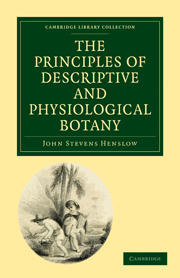Book contents
- Frontmatter
- Contents
- INTRODUCTION
- PART I DESCRIPTIVE BOTANY
- SECTION I ORGANOGRAPHY AND GLOSSOLOGY
- CHAPTER I ELEMENTARY ORGANS AND TISSUES
- CHAPTER II NUTRITIVE ORGANS
- CHAPTER III NUTRITIVE ORGANS — continued
- CHAPTER IV REPRODUCTIVE ORGANS
- CHAPTER V REPRODUCTIVE ORGANS — continued
- CHAPTER VI MORPHOLOGY
- SECTION II TAXONOMY AND PHYTOGRAPHY
- PART II PHYSIOLOGICAL BOTANY
- INDEX AND GLOSSARY
CHAPTER II - NUTRITIVE ORGANS
Published online by Cambridge University Press: 05 December 2011
- Frontmatter
- Contents
- INTRODUCTION
- PART I DESCRIPTIVE BOTANY
- SECTION I ORGANOGRAPHY AND GLOSSOLOGY
- CHAPTER I ELEMENTARY ORGANS AND TISSUES
- CHAPTER II NUTRITIVE ORGANS
- CHAPTER III NUTRITIVE ORGANS — continued
- CHAPTER IV REPRODUCTIVE ORGANS
- CHAPTER V REPRODUCTIVE ORGANS — continued
- CHAPTER VI MORPHOLOGY
- SECTION II TAXONOMY AND PHYTOGRAPHY
- PART II PHYSIOLOGICAL BOTANY
- INDEX AND GLOSSARY
Summary
(38.) Fundamental Organs. — We may refer back to articles 8, 9, &c. for a general notice of the complex organs, which we are now about to describe more in detail, though we do not propose to enumerate all the varieties of form which these organs assume. There are certain appendages both to the stem and root, (or ascending and descending “axes” of vegetation); which are of very little importance in carrying on the function of nutrition. These appendages, as the thorns, scales, tendrils, &c. found on some stems, have without doubt their respective uses; but as the plant may be deprived of them, and still continue to vegetate as freely as when they were present, they are evidently not to be considered as fundamentally essential to the support of life. Moreover, they may in all cases be referred to certain modifications and metamorphoses, which have taken place in one or other of the three organs — the root, stem, and leaf,—which are more especially considered to be the “fundamental organs” of nutrition. The presence of neither of these can be dispensed with without injuring vegetation, and ultimately involving the destruction of the individual; unless where some means have been provided (as we shall see in the case of parasitic plants) to supply their deficiency, or where (as in the lowest tribes of cryptogamic plants) they are probably so blended and confounded together that we are not able to distinguish them.
- Type
- Chapter
- Information
- The Principles of Descriptive and Physiological Botany , pp. 37 - 59Publisher: Cambridge University PressPrint publication year: 2009First published in: 1835

